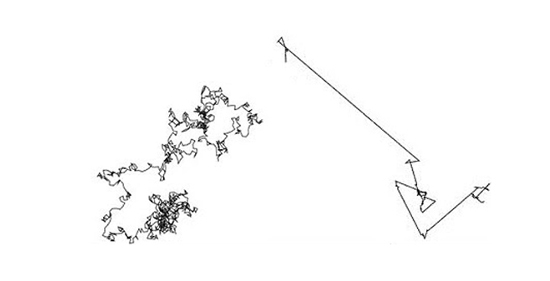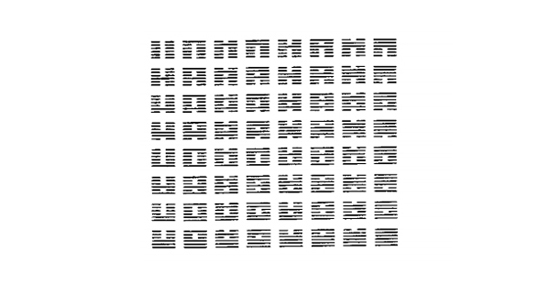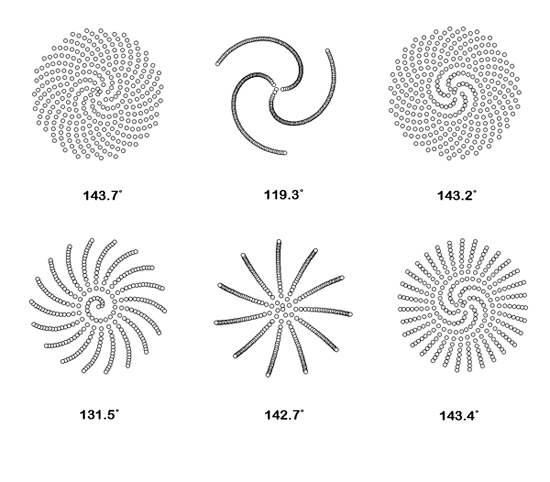Accidental Calculus [Nature, Code, Design]

What are the similarities between ancient arabic systems for automation, origami folding, poetic code, adaptive design, legacy of John Cage or western music tradition including gameflow-like dice music pieces from Johann Philipp Kirnberger or Wolfgang Amadeus Mozart? All of these examples are representing a kind of relation between the logic of the mind and some behavioral aspect of our external environment. On one hand, these activities and artists are bringing forward some aesthetic decisions where creative minds let independent elements into the flow of the creative process to take part in the creation of the piece. Hereby the designer is defining frameworks and boundaries for semi-autonom processes which will lead to the evaluation of the final piece. On the other hand these fundamental processes are not only aesthetic decisions, but ways of thinking about our environment and about ourselves. These are borrowing inspiration from scientific, philosophic and mystic traditions that can be applied to many different fields and phenomena.
When dealing with formalized systems we always have to follow the rules of some procedure. Frameworks are usually constructed of some basic set of rules which might lead to complex structures while iterating and repeating these instructions. These simple set of repetitive rules (or algorithms) are applied to achieve different goals in different contexts and situations (think of any language, for example). Many people like to think that randomness adds value and complexity to their systems because we can not predict its behavior so it will surprise the observer with ever changing, never repeating outputs and combinations. According to a recent interview with Michelle Whitelaw (can’t find the direct link but it has appeared in Neural), it is true in terms of variability, but it is not about adding qualitative values for a system. Random events are really useful for simulating chunks of data for unpredictable behaviors: when we need to simulate unpredictable input values for a system for further investigation. Let’s observe three very basic distribution model.

fig. 1 - Random probabilities. Left to right: a ) no random factor, linear steps. b ) random walk with small amount of randomness. c ) random walk with increased randomness. d ) full range random steps
If we know the parameters of our goal exactly, we can get there by very strict and precise instructions easily. Say, we have a point on a plane, we can get there if we add a simple vector from our starting point to the direction of the given location. Simple & solved. If we know only one parameter of our point we can converge into the desired location by adding some random probabilities to our system. This will be less effective but we will achieve the goal sooner or later. Does it mean if we don’t know any of the coordinates of our point shall we use totally random distribution? Well, not really, because a totally random distribution allows repetition (the following states are not depending on their previous ones) so maybe we will never reach the goal. If we really would like to reach our goal, we still need to use some semi random algorithm where we combine order with chaotic behavior. This can be implemented several ways. We can use some kind of basic random walk algorithm which is not very effective, or we can use very sophisticated path finding algorithms that are way more useful. Or, we can use a straight, ordered algorithm with no random probability like a television scan line when its cathode ray is moving from point to point over each line, sequentially. Or, we can generate random numbers and avoid previously generated ones so finally we will stumble in the position of our point. There are many-many ways to solve a problem. What we chose might depend on the context of the situation (how much time do we have, how precise do we need to be, etc).
Specific distribution models are easily observable in our regular daily routines, also. The temporal distribution of our activities are more or less predictable if we find some patterns and repetitive occurrences between successive events. Hungarian scientist Laszlo Barabasi-Albert found an interesting model that can describe key aspects of our behaviors. He calls these successive events “bursts”. He and his colleagues were observing how frequently people respond to mails, talk to each other or even how often move between two locations. They have found that there are surprisingly big gaps and silence between two active events. It’s obvious that we do not speak for a few hours, then we meet someone and talk a lot. We do not read mails for a few days than we respond all to them within a few hours. Our basic communication structure is working like this. Similarly, but less obviously moving between physical locations are showing bursts and calm series, too. It is not a constant average value how much we travel. If you go to vacation, you move a lot, then for several months you are just moving locally between the places of your regular life. This concept can be extended even to our regular routines, relationships and consumer behaviors.

fig. 2 - Brownian motion (left), Levy Flight (right)
This distribution model is a well known behavior in other natural processes and has the name Levy Flight. According to the blog Seeing Complexity:
“Lévy flights are described by a random walk, which is more or less any mathematical expression of a trajectory with successive random steps, distributed with a non-exponentially bounded probability distribution with theoretically infinite variance. So what does that mean? It is a description of motion. Take as a contrast Brownian motion, which is modeled after random movement of particles in a fluid.A Lévy flight is instead a cluster of movements, some short and some long. It was identified by the late Benoit Mandelbrot, as an outgrowth of chaos theory.”
Why are these facts important from a designer point of view? Think of procedures. Our regular routines are constructed subconsciously from trivial procedures. Our current states are more or less predictable. And if we deal with this potential we might build tools that are easier to understand, that are adapting themselves to a personalized usage. An object that is capable to measure its environment and change its internal structure based on these principles can be adapted more seamlessly and easily to someone’s internal representations. This might lead to some adaptive, invisible interfaces where there is no UI or Graphic Design anymore, but something else. Something, which deals with rhythm, temporality, routines and changing interests, fluid contexts and self regulating algorithms. One might call it contextual design, behavior design or anything that is brought forward by some sort of dynamic nature. Observing rhythms around (and inside) us, temporal sequences, music, dance, human relationships is a key element for asking the right questions within these unexplored territories. Software has meaningful dynamic inputs and deeply reconfigurable internal representations so all type of software can adapt its internal structure according to its environment. Software must be open not only in the regular meaning which refers to its source but also in terms of its behavior. Think of responsive design, reactive architecture, or any open ended process from the art world.
As Bret Victor, a great interventionist and interface designer points out: interaction is good when dealing with manipulation software (editors, games, etc). But once we are dealing with information software where we are more likely to learn instead of create, interaction is turning into interruption. An interface that represents information should work with as less interaction as possible, in order to let the perceptual and cognitive flow go seamlessly. These software might use environmental conditions, reconfigure their behavior when needed. This restructuring is based on some data from the users history, actual physical position, current time and other environmental parameters, but also includes social integration, similar interests and rankings from relevant people etc. The interface must be in real conversation with the context of the user. This type of meaningful relationship is originally described by Gordon Pask who adapted human conversational elements when he was dealing with artificial, responsive input & output systems that took form within (and out of) the fields of cybernetics.

fig. 3 - One sequence of the 64 hexagrams of the I Ching, or the Book of Changes. This ancient system is a method of divination based on a binary system and chance operations.
What are the strategies that we can observe in procedural thinking and algorithmic art? Janett Zweig introduces three basic concepts that she found while studying mystical systems, procedural art and computer practices. In her work “Ars Combinatoria” (pdf link) she makes difference between permutation, combination and variation. These three are formalized concepts for manipulating an existing set of entities (numbers, musical sequences, words etc). Permutation is when we have our set and rearranging its elements in different ways without adding or repeating any new element. Combination is to rearrange and select specific elements, reducing its original set. Making variations means to rearrange the elements of the system with the allowance of repetition, redundancy and multiplication. Her interest in these methods are going far more beyond practical definitions: she is investigating the difference between spiritually based or purely process based methods. She is asking when someone is making a mystical experience via permuting the letters of the alphabet (as with the gates of Sefer Yetzirah or the ancient representations of the Tree of Life) or permuting abstract binary symbols (such as with the I Ching system or modern computer programs), is it a creative transformation, or more like a meditative activity?
According to Zweig these procedural systems went through a qualitative shift from a purely mystical state to a more formal, process based methodology during our history. Starting with great “Mystical Universalist” systems, thinkers and philosophers introduced “Symbolic logic” and logical games which led to different “Semantic Interventions”. These are forming the basis for the concept of “Play” and playfulness that can be found in a wide spectrum of our activities including board games, contemporary music, educational systems.

fig. 4 - Spiral experiments: Generating Fermat (or Archimedean) spirals with modified divergence angles.
What happens if we are using a purely ordered algorithm (such as a formula for a spiral) with no random probabilities? Can we predict the result? It turns out that it is far away from the truth, at least in terms of visual representation. As you see on this visual experiment, each shape shows different characteristics compared to each other. A spiral shape is always present because of the clearly defined, ordered algorithm (r*r) = (a*a)*θ. However as soon as you start tweaking one single parameter a tiny bit (in this case, the parameter of the divergence angle of the system which is variable”a” in the code below) completely different spatial distributions arise. An initial value is repeated and iterated over itself within the loop, thus it has a multiplicated effect which brings forward emerging shapes of visual complexity. A simple implementation in Processing language:
float a; // divergence angle
float c; // scaling factor
int N; // number of dots
float r, phi; // polar coordinates
int j, i; // row, column coordinates
for (int n=0; n<N; n++)
{
phi = n*a;
r = c*sqrt(1.0*n);
j = int( r*cos(phi) );
i = int( r*sin(phi) );
ellipse(j,i,10,10);
}
Addition: an ellipse() is a function to draw ellipses at specified positions with specified dimensions (these are the four parameters of the function). Also, you have to initialize the variables (a,c,N) to run the code.
Language is definitely a permutation of letters from the alphabet. However the meaning and the core concepts of our consciousness are not contained in the discrete elements or parameters and not even between the configurations of these elements which are defined by syntactical rules and grammatical formulas. If we are bringing forward the world and our environment from concepts that are inherited from language, it is more than just communication tool. It is the incubator of analogies that are the core working mechanisms for human thinking as Douglas Hofstadter points it out in his recent book named Surfaces and Essences. It is the landscape around and inside us (be it visual, textual or mental language), it is the transfer channel of memes, it creates the internal representation of the world around and inside us. Some might say: the music is not in the piano.